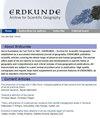Global biomes and ecozones – Conceptual and spatial communalities and discrepancies
IF 1.1
4区 社会学
Q3 GEOGRAPHY
引用次数: 3
Abstract
Various facets of global changes and related problems and challenges are asking for sound impact assessments and corresponding coping strategies. The human impact on nature is a major driver of biodiversity loss and restricted ecosystem functioning and services. Assessing such global changes is often done by using biomes as benchmarks. However, even if the wording and terminology seem common sense (‘tropical rain forest’, ‘steppe’, ‘boreal forest’) global biome units and maps deviate in many ways. This is well justified by their individual intention, expert opinions, disciplinary background, and methodology of creation. A closer look reveals linkages between spatial accordance and common origin in climate classifications and maps. Their original influence, however, is rarely evident. In consequence, it is difficult if not impossible for users to realize and understand differences in these global maps. Furthermore, it is difficult to accept the fact that there is no common standard for global biomes. Even more surprising is the fact that some approaches are uncritically taken for common sense and are perpetuated over decades. This study aims to review established global biome concepts. Regions that are consistently assigned to comparable types of biomes shall be detected and also regions where ambiguity exists. For this purpose, we shortly review the history of existing concepts and the generic relations between them. Biomes, ecozones and climate classifications are considered. We digitized the most prominent biome classifications. Spatial match and mismatch between concepts were analyzed globally. We detect areas of spatial agreement and regions with ambiguous classifications. A clustering approach including 287 individual biomes originating from 12 established global biome concepts and their classifications/units revealed 12 terrestrial biome clusters among which 8 can be assigned to terrestrial ecological units. One cluster on ice caps adds to this. And finally, 3 clusters represent rather transition zones (ecotones), high mountain plateaus or are of minor areal extent. The spatial arrangement of these emerging clusters is displayed on a global map. Additionally, regions of uncertainty related to class assignment were identified. Those primarily occur in the vicinity of mountainous regions. The findings of this study should be seen as a work in progress and as a basis for further optimization of global biome concepts.全球生物群落和生态区——概念和空间上的共同性和差异
全球变化的各个方面以及相关的问题和挑战都要求进行健全的影响评估和相应的应对战略。人类对自然的影响是生物多样性丧失和生态系统功能和服务受限的主要驱动因素。评估这种全球变化通常以生物群落为基准。然而,即使措辞和术语看起来是常识性的(“热带雨林”、“草原”、“北方森林”),全球生物群落单位和地图在许多方面都存在偏差。他们的个人意图、专家意见、学科背景和创作方法都很好地证明了这一点。仔细观察就会发现气候分类和地图中空间一致性与共同起源之间的联系。然而,它们最初的影响却很少显现出来。因此,用户很难(如果不是不可能的话)意识到和理解这些全球地图的差异。此外,很难接受全球生物群系没有共同标准的事实。更令人惊讶的是,有些方法被不加批判地当作常识,并延续了几十年。本研究旨在回顾已建立的全球生物群系概念。应检测一贯分配给可比类型的生物群系的区域以及存在歧义的区域。为此,我们将简要回顾现有概念的历史以及它们之间的一般关系。考虑了生物群落、生态带和气候分类。我们将最重要的生物群系分类数字化。整体分析概念间的空间匹配和不匹配。我们检测空间一致的区域和分类不明确的区域。通过对来自12个已建立的全球生物群系概念的287个生物群系及其分类单位的聚类分析,得到12个陆地生物群系,其中8个属于陆地生态单元。一组关于冰帽的数据进一步说明了这一点。最后,3个集群代表过渡带(过渡带)、高山高原或面积较小的区域。这些新兴集群的空间布局显示在全球地图上。此外,确定了与班级分配相关的不确定区域。这些主要发生在山区附近。这项研究的结果应被视为一项正在进行的工作,并作为进一步优化全球生物群系概念的基础。
本文章由计算机程序翻译,如有差异,请以英文原文为准。
求助全文
约1分钟内获得全文
求助全文
来源期刊

Erdkunde
地学-自然地理
CiteScore
2.00
自引率
7.10%
发文量
17
审稿时长
>12 weeks
期刊介绍:
Since foundation by Carl Troll in 1947, ''ERDKUNDE – Archive for Scientific Geography'' has established as a successful international journal of geography. ERDKUNDE publishes scientific articles covering the whole range of physical and human geography. The journal offers state of the art reports on recent trends and developments in specific fields of geography and comprehensive and critical reviews of new geographical publications. All manuscripts are subject to a peer-review procedure prior to publication. High quality cartography and regular large sized supplements are prominent features of ERDKUNDE, as well as standard coloured figures.
 求助内容:
求助内容: 应助结果提醒方式:
应助结果提醒方式:


